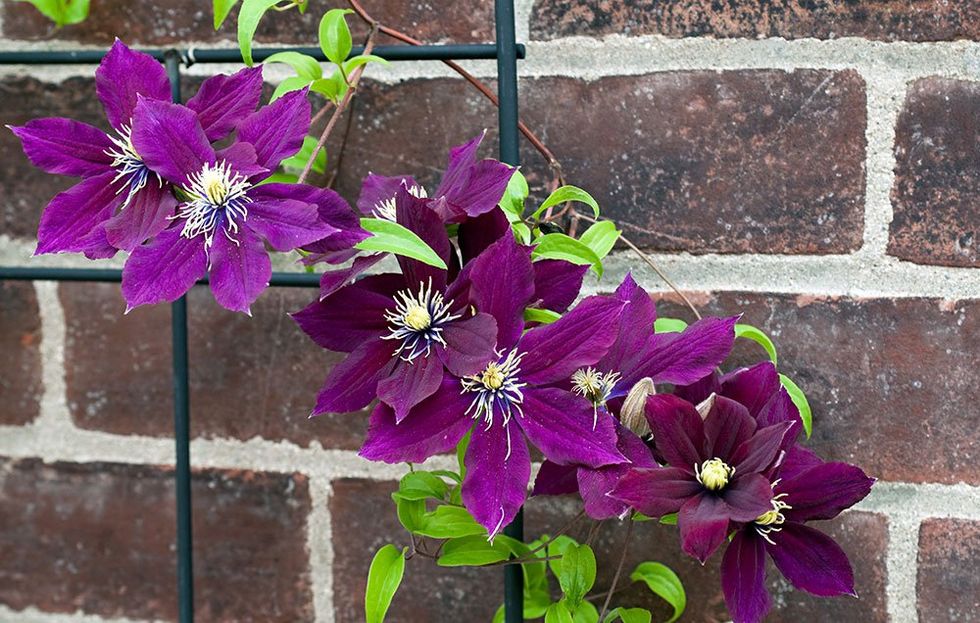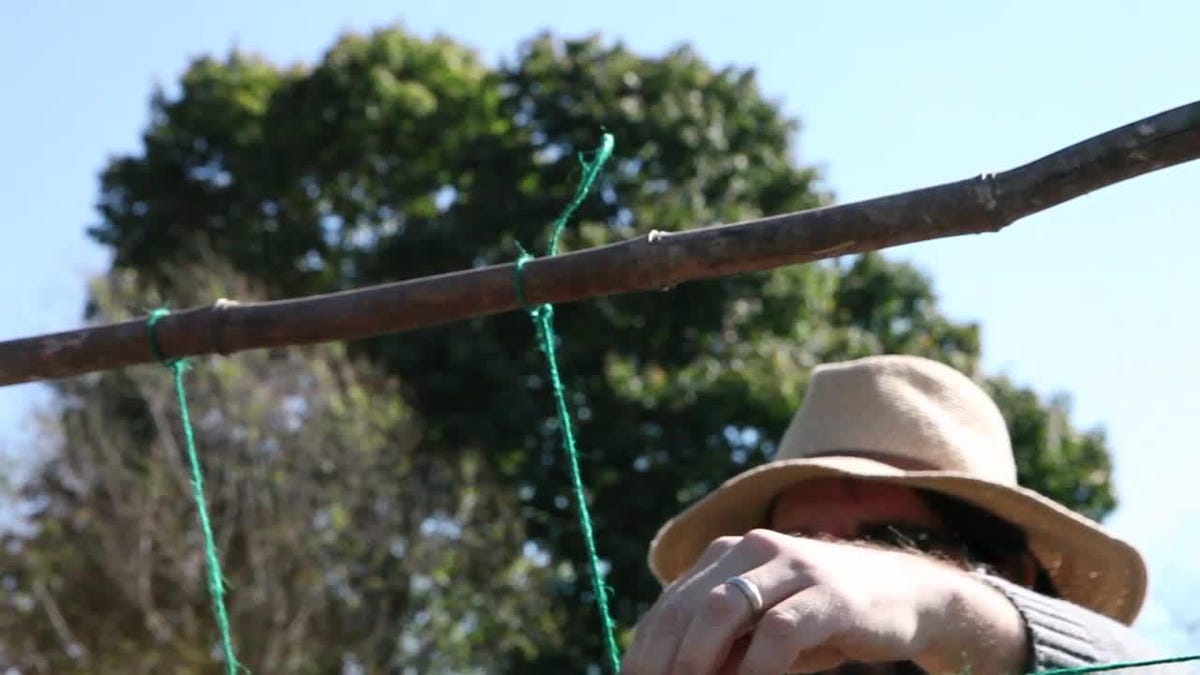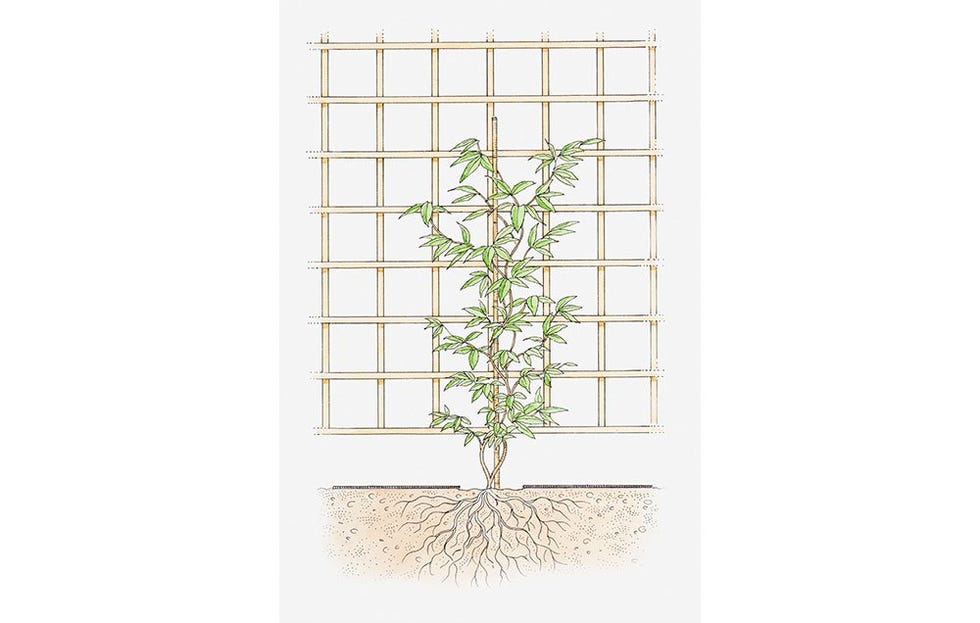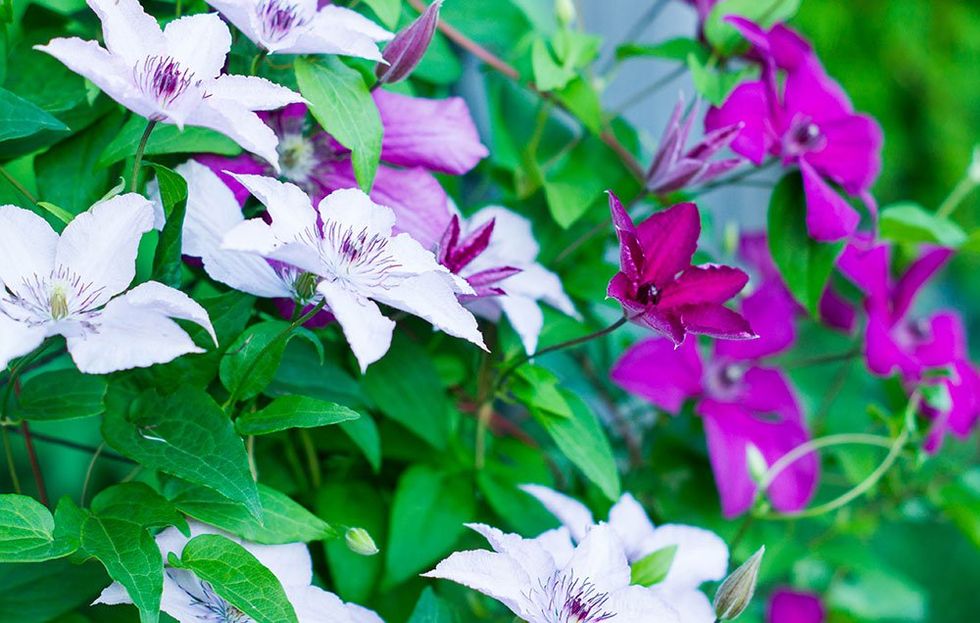Clematis (pronounced klem'uh-tis, accent on the first syllable) means “climbing plant” in Greek. And indeed, no matter how tall or how vigorous a flowering vine you want, or what color, or in what season you would like it bloom, there is probably a clematis vine that fits the bill: This showy family contains 300-plus members—mostly vines, though there are a few perennial shrubs and perennial flowers in the bunch—and there are hundreds of amazing hybrids on top of those.
(Whether you're starting your first garden or switching to organic, Rodale’s Basic Organic Gardening has all the answers and advice you need—get your copy today!)
Clematis varieties come in every color of the rainbow, including vibrant true blue and stunning bi-colors. Many have large, wide, flat flowers; some are fully double flowers like mums; and a few even have bell-shaped blossoms. Some varieties also produce striking, fluffy seed heads that persist into the winter and add interest long after the flowers and leaves have gone. (Here’s how to keep your garden looking great all winter.)
Where To Buy
Most clematis are hardy throughout much of the U.S., but do check the hardiness of any plant, or seeds, before buying to make sure it will be hardy for your garden. At the northern edge of a plant’s hardiness zone it may die back to the ground each year, but summer and fall bloomers will still give you a great display.
Your local nursery or favorite gardening catalog probably carries a few different colors of the familiar large-flowered hybrids and perhaps one or two others.
For more variety, you will probably have to turn to a specialty nursery. Four mail-order nurseries worth checking out are:
Brushwood Nursery, Unionville, PA
Completely Clematis, Ipswich, MA
Garden Crossings, Hudsonville, MI
Joy Creek Nursery, Scappoose, OR
Where To Plant
Clematis need three things: at least 6 hours of sun a day during the summer (though a little shade in mid-day is helpful in hot climates); something sturdy to climb on; and cool, moist, well-drained soil.
Plant clematis where it will get 6 hours of sun, either next to an existing fence or wall (which will make it easy to stand up a suitable trellis), or where you can build a sturdy structure for it to climb on. Clematis vines do well on these self-supporting, easy and super-strong arches made out of 4’ X 16’ welded wire fence panels; or a sturdy, freestanding trellis. Less vigorous varieties, such as many of the large-flowered hybrids can be allowed to climb through shrubs or small trees in the flower garden (with a little guidance), instead of being trellised, or even to wander over the ground as a ground cover.
Once you know where you will by planting, come up with a plan for keeping the soil cool and moist. You can do this by providing low shade with short, annual plants like begonias or petunias, or by using mulch.
Many of the large-flowering varieties do well in large containers, just be sure to use a moisture retentive soil mix and/or a self-watering container, and provide a secure trellis.
How And When To Plant
You can plant bare-root clematis in spring, late summer, or early fall; potted clematis any time from spring through early fall.
Dig a hole at least twice as deep and wide as the pot or root ball of your plant within a few inches of your trellis or other support. Mix lots of compost or other organic amendments, such as coir fiber, with the soil you removed to help hold moisture.
If you have very acid soil, mix in a handful of lime or wood ashes, as clematis prefer a neutral soil pH. Shovel enough soil mix back into the hole so that when you set your plant on it, the top of its soil is about 2”-3” lower than the surrounding garden level. Refill the soil around the plant, adding water every few inches, to help settle the soil. Level the soil, so that the bottom 2”-3” of the stems are covered.
Insert a few short sticks into the soil near the base of the stems and leaning up to the trellis if the vine isn’t long enough to reach its support, so that it will be able to climb up to it right away. Clematis vines are fragile, and you want to train them to grow where you ultimately want them to be rather than trying to move them later.
Spread a thick layer of organic mulch or lay large, flat stones around the vine, leaving a small open area around the stems, to help keep the soil around the roots cool and moist. (Here's what every gardener should know about mulching.)
(Sign up for our FREE newsletter to get clever kitchen tricks, gardening secrets, and more delivered straight to your inbox!)
Care
Keep your new perennial well-watered during the first year, especially if the weather is dry. Clematis are hungry plants and will appreciate a sprinkling of a good all-purpose organic fertilizer every month or so during the growing season.
Tie vines to their support as necessary as they grow. Unlike many more tenacious climbers, clematis shoots only twine themselves loosely around things as they seek to climb from the garden toward the sky; shoots can break from their own weight or from being lashed about by wind—and any that snap off reduce the overall height and number of flowers the vine will produce that year.
In the fall, if your mulch has decomposed or shrunk, add more before cold weather sets in, and make sure the spring and early summer bloomers are securely tied to their support so they will withstand winter winds.
Trouble-shooting
Certain types of clematis can be slow to establish, especially if planted as bare root plants, so be patient if yours doesn’t do much the first year or two. Give it three or four years before writing it off.
Brown leaves near the bottom of the perennial may just be a sign of heat and water stress: give your plant plenty of water and it should send up new growth as the weather gets cooler.
If a whole vine suddenly wilts and turns brown or black during the growing season it may have a disease called Clematis wilt: remove all the damaged foliage, cutting back into healthy stem (under the soil if necessary). Burn or landfill the trimmings and clean your pruner with a 10% bleach solution or rubbing alcohol to prevent further infections. Vines usually send up new, healthy shoots.
Pruning
It's the confusing advice that deters so many gardeners from growing clematis. You may have heard that pruning clematis is complicated, but don’t believe it. It is pretty simple if you just think about when each vine blooms (spring, summer, or fall) and prune it after it finishes flowering. Also, rest assured: neither skipping, nor pruning at the “wrong” time will kill your perennial, and at the very worst you might miss a year of flowering.
Ignore those gardening books that promise that some clematis don't need pruning at all. Pruning increases flowering, and not just at the ends of the vines (most of which eventually grow over your head, putting the flowers out of your sight); it also stimulates the perennial plant to put out more shoots from the base, so the entire plant becomes fuller and more floriferous.
Start by taking out any dead, diseased, or damaged wood. Then follow the directions below, depending on when your clematis blooms.
Pruning group A (or 1)
A is for After bloom
Includes: Species that bloom in early spring, such as C. montana, C. armandii, or C. macropetala.
When and how to prune: Don't prune until after the flowers are finished. Flower buds were formed the previous year, so if you prune before they flower, that means no flowers for you that year.
Pruning Group B (or 2)
B is for Before bloom
Includes: Species that bloom in late spring/early summer, including most large-flowered types.
When and how to prune: In spring, cut back to a set of live buds, about a third down from the top. Hard-prune (to about 12 inches) for the first two years after planting to develop a strong root system.
Pruning Group C (or 3)
C is for Cut back hard
Includes: Species that bloom in summer/early fall: C. viticella, C. tangutica, C. virginiana, C. texensis, C. crispa.
When and how to prune: In early spring, cut every stem to 12 to 18 inches or so.

















